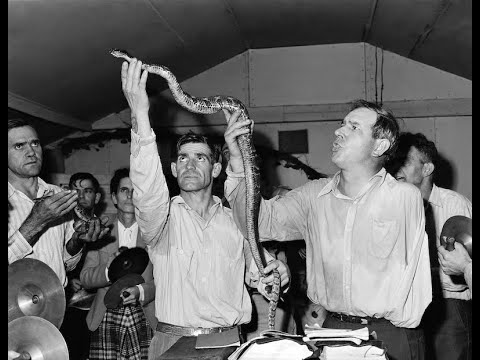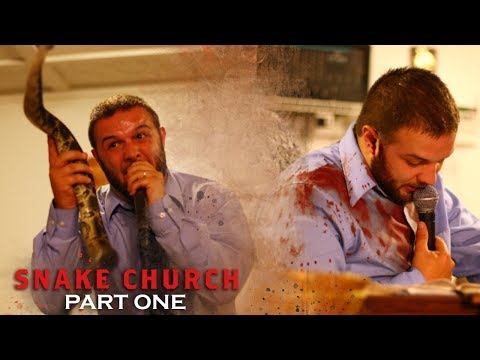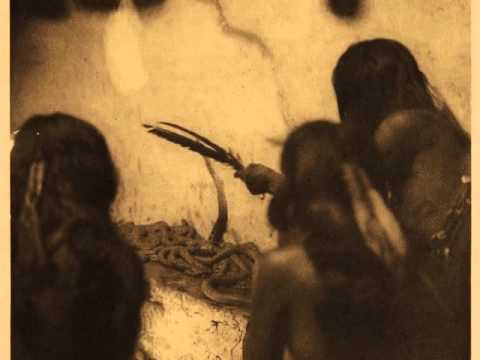Along the way, many faiths may involve unorthodox practices. For some, that includes the use of various animals in religious ceremonies. And for many churches across America, there is one specific animal in use: snakes. The practice of handling snakes as a form of faith is not a new thing. In fact, it dates back more than a century. Even today, it is mainly associated with rural churches in the Appalachian region of the U.S. Most of those churches have links to Pentecostal Christianity and other charismatic denominations. The practice is based on a biblical passage that states the faithful will be protected from harm when handling snakes or drinking poison. These churches really put that passage to the test! Although it is considered a uniquely American religious observance, similar practices can be found in other religious contexts dating further back in history. Snake handling remains a dangerous and dramatic ritual that has played a significant role in religious history. In this list, you’ll learn all about some of the craziest, most fascinating, and most dangerous aspects of snake handling in church.
10 The Humble Beginnings of Snake Handling
The ritual of handling snakes in religious ceremonies is closely connected to certain sects of Protestant habits. Most notably, rural churches throughout the Appalachian region have a long history of working with slithery serpents. The origin of this practice is often attributed to George Went Hensley, a resident of Tennessee. As the legend goes, he brought a snake to a church service in 1909. In 1914, Hensley received informal approval from the Church of God to do more with snakes. For years, things went well. But by the late 1920s, the church distanced itself from the practice. Despite this, snake handling had already become established and widespread in the Appalachian churches and those in other parts of the south. Hensley’s habits were too popular to turn back. And yet the practice of handling snakes in church services as a demonstration of faith to God may not have been his invention alone. Instead, some historians believe the tradition was begun by a woman named Nancy Younger Kleiniek. According to longtime pastor Jimmy Morrow, Kleiniek was known for using snakes in revival shows across the Southeast. Her faith work took the woman of God to places like Tennessee, Kentucky, and the Carolinas throughout the 1890s. She reportedly handled snakes and spread the Gospel for years. It’s possible Hensley could have even acquired his snake-handling ideas from her. Regardless, the practice proved popular almost from the start.[1]
9 Snake Handling Comes from Several Bible Verses
Many churches that involve themselves in snake handling base their practices on certain verses from the Bible. These passages specifically instruct believers to handle serpents, church leaders say. This interpretation is often derived from a literal reading of the scripture. One such verse is found in Mark 16:18, which states, “They shall take up serpents; and if they shall drink any deadly thing, it shall not hurt them: they shall lay their hands upon the sick, and they shall recover.” Additionally, Luke 10:19 states, “Behold, I have given you power to tread upon serpents and scorpions, and upon all the power of the enemy: and nothing shall hurt you.” Obviously, it’s easy to see how these true believers can follow through with the practice of snake handling. In some cases, churches may also reference the account of Apostle Paul in Acts 28:1-6. In that verse, he famously handled a venomous snake without harm despite being bitten by it. Despite this, many religious communities continue to disagree on the proper interpretation of these texts. Some contend that taking the verses in a literal sense is inadequate. Instead, they say, the mention of “serpents” can be symbolically understood as an allusion to wrongdoing or malevolent forces on Earth. Additionally, some may question the rationale behind challenging God’s will. After all, to them, Matthew 4:7 famously states, “Thou shalt not tempt the Lord thy God.” For those with doubts, handling a venomous snake during a religious gathering could be seen as such a test. But the true believers care not! For more than a century, these southern Christians have backed their unique ways of worship no matter what outsiders may say about it.[2]
8 It Has Always Appealed to Appalachian Believers
The practice of handling snakes has, in the past, been associated with various cultures and religions around the world. However, now it is most closely identified with the isolated communities of Appalachia. Those who practice it are particularly found in the area’s southern regions. The origins of this tradition can be attributed to a combination of historical beliefs, isolated churches, and an element of chance. As we’ve seen already, George Hensley is considered one of the people who brought snake handling to these Protestant churches in the area. His charismatic influence greatly contributed to its popularization, which really began in Tennessee. Had Hensley been situated elsewhere, it’s possible snake handling would be synonymous with devout religious groups found in rural areas all over the country. But the seclusion and close-knit communities of Appalachia made it ripe for spreading. Churches located in the Midwest were occasionally known to have incorporated the ritual of handling snakes in the past. That mostly came about due to new followers bringing the tradition with them from the Appalachians. The current prevalence of this practice in other areas is uncertain, though. What historians know without question is the practice’s mountain roots. According to a report by NPR from 2013, approximately 125 churches are believed to still partake in snake handling. These small, local churches are primarily situated in a region encompassing the southernmost part of the Appalachian Mountains spread across Alabama, Georgia, and the Carolinas. Even with that spread, many states have banned the practice. They cite worries about the safety of those handling the venomous snakes as the primary reason for concern.[3]
7 Many Snake Handlers Do It in Secret
Today, there is quite a stigma around snake handling. Churches that engage in the ritual are often reluctant to publicize their practices. For many, that’s because of the legal implications that arise when venomous snakes are present at religious revivals. In many jurisdictions, the practice has been banned outright. That’s due to several tragic fatalities that have occurred in the past. Take the 1947 Tennessee law that was passed in response to the deaths of multiple churchgoers in a brief period. Despite being a fervent expression of devotion that is accepted by a congregation, the handling of snakes can still result in criminal charges. Simply put, many states believe it’s just too dangerous to encourage the practice among their faithful. The controversy of the practice also has a social aspect to it. In the early 1900s, the handling of snakes in religious settings was becoming increasingly prevalent. Some religious leaders, including those of the Church of God sect of Pentecostalism, gave it their unofficial endorsement. However, as the Church of God gained more widespread popularity, the practice of dealing with dangerous snakes started to come under scrutiny. Many within the denomination chose to abandon snake handling altogether. They were concerned with the general public’s view on it and wanted to attract more moderate parishioners. However, some smaller congregations refused to let go of the tradition. They lost the support of the larger organization around them, but they kept at it. For members of these dissenting outlier churches, it was wise to keep their practice under wraps in certain circles. Today, with snake handling outlawed in many areas, the places where it continues to thrive generally keep it very, very quiet.[4]
6 Deadly Snake Bites Are Part of the Gig
The harsh reality is that regardless of one’s spiritual beliefs or devotion to a higher power, handling snakes can prove fatal. This was tragically demonstrated in the case of Kentucky pastor Jamie Coots. He had gained notoriety for his participation in various media coverage of snake handling over the years. But in 2014, Coots was bitten by a rattlesnake during a service and refused medical attention. When he later fell unconscious at home, his wife also refused treatment. Sadly, while the Coots family relied on faith, the venom ultimately led to his death. But while some viewed this as a testament to Coots’s faith and submission to divine will, others were more skeptical of the events of his passing. Fellow pastor Andrew Hamblin, who had previously been vocal about the practice of snake handling in his own church, discontinued the practice following Coots’s death. “Since Jamie died, I’ve offered a rattler to no one,” he told National Geographic. “I am the shepherd, and I am responsible for what happens in this building.” As more serpent-handling ministers come forward, the call for immediate medical assistance after snakebites is being more widely embraced. There is no religious doctrine that prohibits seeking emergency aid. Even among those deeply devoted to their faith, medical attention is a necessity. In fact, individuals like “Little Cody” Coots—the son of the late snake-handling pastor—have themselves advocated for emergency attention following a serpent strike. In Cody’s case, it may have saved his life after he was bitten during a service in 2018. But other pastors in recent years haven’t been so lucky. And snake-handling can still lead to death in the most tragic of scenarios. Still, it seems the community of snake handlers is becoming increasingly aware of the dangerous nature of their practices. First responders hope they are beginning to see the importance of being prepared for anything. Whether one agrees with these beliefs or not, there is no question that seeking medical attention in the event of a snakebite is a wise choice.[5]
5 Snake Handlers Have Deeper Motives
From an outside perspective, the ritual of snake handling may appear to be a mere spectacle. To many critics, it merely perpetuates negative stereotypes about uneducated and superstitious individuals. The longtime residents of Appalachia and other rural areas of the south have been on the receiving end of this view for centuries. Watch this video on YouTube However, such a viewpoint disregards the deep-seated convictions of those who partake in the practice. It also ignores the nuanced reasoning that leads one to use venomous snakes as a means of glorifying God. It’s worth noting that practitioners do not necessarily view themselves as immune to the dangers of snake bites. Even as some interpret scriptures in the Bible to support the practice, they are well aware of the risks they are taking. Despite the inherent risks, snake-handling believers firmly trust in their faith and God’s will. They understand that handling snakes means there is real potential for harm or even death. However, this is a choice they make willingly in order to express their unwavering devotion to their religion. These practitioners believe that true faith involves facing real-world consequences, as opposed to simply paying lip service to religious tenets. In their eyes, anything less is a rejection of the complete teachings of their faith. Say what you will about snake handlers, but they certainly put their money where their mouth is in this regard. While most people would never come close to this environment, they willingly test God’s glory every day—regardless of whether that’s wise or practical.[6]
4 The Legal Debate Around Snake-Handling Is Tense
Handling snakes, particularly venomous ones, may hold cultural or personal significance for some southerners. But as a practice, it continues to face legal scrutiny in the interest of public safety. Despite the fact that the United States Constitution guarantees freedom of speech and religion, legislators and law enforcement officials in many regions have deemed handling snakes to be an action that should be regulated. They are rightfully concerned about the potential risk it poses to the public. Since handlers are performing this action in front of crowded rooms of parishioners, the potential liability is just too great. Over the years, laws have been put in place to restrict snake handling across many states. Even today, they continue to be a hot topic of debate. But that doesn’t mean true believers haven’t fought back for their rights too. Despite the religious freedom granted to snake handlers, legal disputes can still occur. One such instance occurred in 2013 when Kentucky-based Pastor Andrew Hamblin was charged with unlawfully owning the slippery serpents. Wildlife officials had taken around 50 venomous snakes from the minister’s possession. He pleaded innocent and claimed the state infringed upon his constitutional right to freedom of religion. The case ultimately came to an end without a legal resolution, though. Hamblin was free to walk on the charge. It may have gotten him off the hook in the short run. However, questions about the legality of snake handling will no doubt be a contested topic for this tight-knit group of people for some time to come.[7]
3 Most Encounters Aren’t Actually Deadly… for the Humans
As we’ve seen, the tales of pastors and congregants being bitten by snakes are not uncommon. However, it is intriguing to learn that many people can safely handle venomous reptiles without any harm, too. One might wonder how they are able to manage these creatures without causing them to become defensive and inflict a bite. The truth is that there is a strategy to take in the practice. Expert handlers approach snakes in a cautious and gentle manner. Even pastors who appear to be in a trance-like state do their best to be calm and controlled. The snake, then, may be less likely to bite. Of course, it should be noted that most experts would recommend not handling snakes under any circumstances. But these pastors still try to game their luck a bit when they do. The conditions in which snakes are housed and cared for can greatly influence all this. The better they are treated, the lesser the likelihood they have of biting their handler. Furthermore, a snake in poor health may not be able to inject a full amount of venom when it strikes. Many experts in the field have observed that these snakes are often kept in subpar environments. They are subject to unsanitary, overcrowded enclosures and inadequate access to water and food. Jamie Coots, the pastor mentioned above who died while handling a snake in 2014, candidly acknowledged his snakes would typically only survive for a few months in captivity. That is opposed to the decade or more that snakes in properly managed zoos can live. So there is a question about handling and health here. But paradoxically, the snakes’ poor quality of life within these churches may actually make their venom somewhat less deadly.[8]
2 Sometimes, It Actually Works Out
So, if these snakes are so dangerous, why don’t they bite their handlers every single time? Could God really be intervening in these cases? And thus, are snake-handling preachers proven correct by the fact that they survive most of these encounters? While it is technically feasible for individuals to handle snakes without injury, the practice is discouraged by those outside the community. Despite one’s belief or the strength of the snake, it remains a risk to be bitten by a venomous animal. That should be obvious, right? After all, that is something Coots himself experienced multiple times in his church. But there’s also a success rate in this dangerous game. In the past, Coots and other pastors have shared that many people who were bitten recovered without medical intervention or antivenom. Of course, that’s no guarantee, as Coots himself found out in 2014. But there are people who survive snake-handling events, even as crazy as the act may be in the first place. So, what happens to certain fortunate members of a congregation who are bitten by snakes but do not die? Some individuals may attribute it to their own belief in the faith and protection of a higher power. However, plenty of other skeptics demand a more tangible scientific explanation. And experts in the field of herpetology may have one. They argue these snakes used in religious ceremonies are very often underfed and not properly cared for in their enclosures. Thus, they may not possess the ability to inject a significant amount of venom with a single bite. Even if they do snap on their handler, the end result is relatively weak compared to a healthy snake in the wild. Furthermore, experts wonder whether these snakes may have already expelled a significant amount of their venom in prior strikes. Thus, each successive bite is rendered just a little bit less venomous. So when it happens, it’s not the catastrophe people would expect in a normal scenario. That still doesn’t mean we’d take our chances with a bite, of course…[9]
1 Snake Handling Has a Presence All over the World
The handling of snakes is not solely a Christian practice. It appears in other religious and spiritual traditions as well. Historians have found it prevalent in many of the ceremonies and artwork of Mesoamerican cultures. It has been present in the past during the veneration of the spirit Dambollah in Haitian voodoo. The Pueblo people of the American Southwest had a notable shamanic practice of collecting rattlesnakes and dancing with them. The Yokut tribe of California’s Central Valley used the practice as a way to prove one’s power. In their experience, the Yokut would encourage snakes to bite people. Surviving it showed powerful tendencies and faith in a higher calling. Throughout history, even more groups have handled snakes for religious and communal reasons. For example, the indigenous Chumash community performed a dance with snakes that served as a method to decide whether or not to consume snake meat. A scientific journal article from 1943 famously described a custom among members of the Hopi tribe involving serpents. In the act, they would dance with snakes and, in some cases, even hold them in their mouths. Some said they were protected from being harmed as long as they were morally upright individuals. Others suggested that it was due to their knowledge of snake behavior. Some anthropologists have even wondered whether they employed some sort of substance that made the snakes docile. Either way, snake handling was a part of the cultures of many communities. Rare though it may be, it’s not just a Christian thing. That doesn’t make it any less alarming, though![10]

















